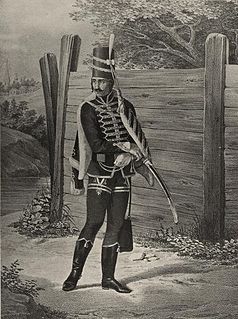A private is a soldier of the lowest military rank.
Generalleutnant is the Germanic variant of Lieutenant general, used in some German speaking countries.
Gefreiter is a German, Swiss and Austrian military rank that has existed since the 16th century. It is usually the second rank or grade to which an enlisted soldier, airman or sailor could be promoted.
Unteroffizier is a junior Non-commissioned officer rank used by the Bundeswehr. It is also the collective name for all non-commissioned officers in Austria and Germany. It was formerly a rank in the Imperial Russian Army.

Wachtmeister is a military rank of non-commissioned officers (NCO) in Austria and Switzerland. The Wachtmeister was initially responsible for the guard duty of the army. Later, it became the Feldwebel equivalent NCO-grade of the cavalry and artillery. Besides Austria and Switzerland today, the rank was also used elsewhere, for example in Germany, Russia, and Poland (wachmistrz).
Fähnrich is an officer candidate rank in the Austrian Bundesheer and German Bundeswehr. The word Fähnrich comes from an older German military title, Fahnenträger, and first became a distinct military rank in Germany on 1 January 1899. However, Fähnrich ranks are often incorrectly compared with the rank of ensign, which shares a similar etymology but is a full-fledged commissioned officer rank.
Fähnrich zur See designates in the German Navy of the Bundeswehr a military person or member of the armed forces with the second highest Officer Aspirant rank. According to the salary class it is equivalent to the Portepeeunteroffizier ranks Bootsmann (Marine) and Feldwebel of Heer or Luftwaffe.
Seekadett is a military rank of the Bundeswehr and of former German-speaking naval forces.
Korporal is the German and Danish spelling of the English corporal. Korporal is used in a number of armed forces as the lowest rank of the non-commissioned officers group. However, in the German Bundeswehr, it is considered a high enlisted personnel rank. In Switzerland the rank is used in the Fire Department as well.
Oberstarzt (OTA) is a military rank in German speaking armed forces. It denotes a medical staff officer surgeon or medical staff officer dentist and is comparable to Colonel (de: Oberst) or Captain (naval) (de: Kapitän zur See) NATO-Rangcode OF5 in anglophone armed forces.
The rank insignia of the federal armed forces of the Federal Republic of Germany indicate rank and branch of service in the German Army, German Air Force, or the German Navy.
Oberwachtmeister (OWm) is in Austria and Switzerland a military rank of non-commissioned officers (NCO). Besides Austria and Switzerland today, the rank was also used for example in Germany and Russia.
Stabswachtmeister is in the Austrian Bundesheer a NCO-rank. As lowest grade of the Staff-NCO rank group he is normally dedicated to command a platoon or to serve in a military staff appointment. However, he might also be assigned to command a military squad.
The Ranks of the Bundesheer are the military insignia used by the Austrian Armed Forces. Austria is a landlocked country and has no navy.
Assitenzarzt was a military rank in the Austrian-Hungary Common Army until 1918 and in German Reichswehr and Wehrmacht until 1945.
Stabsgefreiter is the second highest rank of enlisted men in the German Bundeswehr, which might be comparable to Corporal (OR-4) in Anglophone armed forces.
Soldat refers to the lowest rank of enlisted men in the land-based armed forces of Germany, Austria and Switzerland. It is usually grouped as OR-1 within the NATO ranking system, excluding the Swiss armed services which is not part of NATO.
Stabsunteroffizier is a military rank of the German Bundeswehr. It was preceded by the rank Unterfeldwebel that was used between 1935 and 1945 in the armed forces of Nazi Germany, the Wehrmacht. The East German National People's Army used the rank Unterfeldwebel from 1956 to 1990. In the Austrian Armed Forces Stabsunteroffizier is the collective name to all higher Non-commissioned officers.

Waffenfarbe(n), also Egalisierungsfarbe(n) are colors that communicate the rank and arm of service for members of the Federal Army of the Republic of Austria and the police. They are also referred to as Kragenspiegel.
Charge(s) used to be the generic term to the military ranks above the rank group of enlisted personnel in German speaking armies. In the today’s Austrian Armed Forces it is the designation to the rank group OR2 to OR4, which comprises the ranks Gefreiter, Korporal and Zugsführer.








